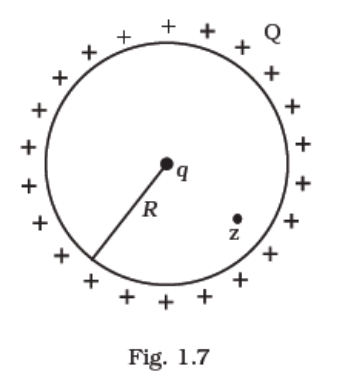A positive charge Q is uniformly distributed along a circular ring of radius R. A small test charge q is placed at the centre of the ring (Fig. 1.7). Then
(a) If q > 0 and is displaced away from the centre in the plane of the ring, it will be pushed back towards the centre.
(b) If q < 0 and is displaced away from the centre in the plane of the ring, it will never return to the centre and will continue moving till it hits the ring.
(c) If q < 0, it will perform SHM for small displacement along the axis.
(d) q at the centre of the ring is in an unstable equilibrium within the plane of the ring for q > 0.

Here, the positive charge Q is uniformly distributed on the outer surface of the ring. Thus, the electric field inside the ring is zero. So, the effect of electric force on charge q due to the positive charge Q is at the centre zero.
When q < 0, force between Q and q is attractive. If q is displaced away from the centre in the plane of the ring, the net force on one side decrease and other side increase by the same amount. So, it will be pushed back towards the centre.
When this charge is displaced towards the axis of the ring, it will gain potential energy and will be pulled by the ring (towards its centre). Due to increase in kinetic energy, it will cross the centre and again gains potential energy. Afterwards, it will be again pulled towards the centre and this process (SHM) will continue due to interconversion of energies.
When q > 0, force between Q and q is repulsive. If q is displaced away from the centre in the plane of the ring, again, the net force on one side decrease and other side increase by the same amount. So, it will be pushed back towards the centre.
Within the plane of the ring, the equilibrium is stable as the charge q tends to move back to its position.
